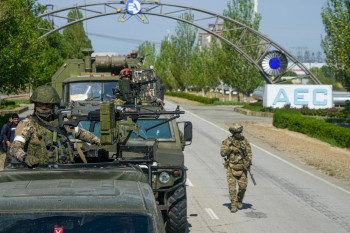Life on the front line of Russia’s new nuclear brinkmanship

NIKOPOL – On nights when he hears them, Mykhailo Kling runs to his panoramic ninth-floor balcony in Nikopol to watch Russian rockets being fired at his hometown.
“See the reactor buildings there,” he said, pointing across the wide expanse of the Dnipro River at the eerie shapes of the Zaporizhzhia Nuclear Power Plant reactors jutting out from the opposite bank.
“Sometimes Russians launch (shells) from behind them, from Enerhodar, and sometimes they come out from the side (of the reactor to fire) and hide away again straight after.”
The nearly 10-kilometer-wide Dnipro River separates the Ukrainian-held Nikopol, home to over 100,000 before the war, and the city of Enerhodar, built around Europe’s biggest nuclear power plant, and since March 4, occupied by Russian forces.
The plant in occupied Enerhodar has been at the epicenter of Russian nuclear blackmail.
Repeated Russian shelling from within the plant’s territory, causing one of the reactors to shut down, has put the entire region at risk.
The six monolithic reactors of the Zaporizhzhia plant have loomed large over Nikopol for decades. Now, with the plant occupied by Russian forces and fears of a nuclear catastrophe mounting quickly, the city is bracing itself for the worst.
Face-off with catastrophe
When the nuclear plant was initially seized in early March, the danger of nuclear disaster was immediately apparent to residents of Nikopol.
“When they first took the station, everyone was panicking; many of us feared this could happen for a long time,” 20-year-old local journalist Mykyta Sayenko told the Kyiv Independent.
When city authorities began handing out iodide pills, people were standing in line for hours to get them, Sayenko said.
The power plant’s capture was followed by months of relative calm on both sides of the river. However, in mid-July, Russian forces renewed the shelling of Nikopol in earnest, including from the territory of the plant.
Reports of deteriorating conditions at the plant have attracted worldwide attention in recent weeks.
UN Secretary-General Antonio Guterres has repeatedly called for Russian military equipment to be withdrawn from the territory of the plant, while on Aug. 19, Russian dictator Vladimir Putin blamed Ukrainian shelling for risking “nuclear catastrophe” during a telephone call with Emmanuel Macron.
Amid the global media noise, attempts have also been made to stir up panic in Nikopol.
On Aug. 10, Yevhen Yevtushenko, head of the Nikopol District Military, posted a photo of a leaflet distributed in residential areas of the city.
The flyer was written in Ukrainian but littered with grammatical errors. “The shelling of the Zaporizhzhia Nuclear Power Plant is ongoing,” it read.
“In the event of a reactor explosion, you will hear a loud boom, accompanied by a bright blue-white light.” Residents were advised to cover their windows with wet towels and quickly leave the city.
In an interview with the Kyiv Independent, Yevtushenko, 44, commented on the mysterious leaflets.
“It’s clearly a Russian fake,” Yevtushenko said, “which they created in order, firstly, to drive people into panic on the territory, and secondly, to support and develop this myth about shelling from our side of the nuclear power plant.”
In early August, the International Atomic Energy Agency (IAEA) reported damage from shelling to the external power supply and communication infrastructure of the plant. Both sides accused the other of shelling the territory of the plant.
On Aug. 25, Ukraine’s state-run nuclear agency Energoatom reported that, amid shelling, the nuclear plant was disconnected from the grid.
Whether a potential nuclear disaster would be triggered deliberately or not, Sayenko is blunt about the threats to both Nikopol and the rest of Europe.
The 1986 Chornobyl nuclear disaster is in living memory, and residents remain on edge about the threat of a repeat.
“I really can't make sense of the idea that they (Russians) could willingly put their own people in such grave danger,” said Sayenko. “But you just can’t put anything past them at the moment.”
Exchanging fire
While Kling, 72, watches the Russian rocket from his balcony, his wife Lyubov Harmash, 68, has less dangerous ways of understanding who is shooting where.
Harmash’s mother and sister live on the other side of the Dnipro River occupied by Russia, in the village of Vodyane. Occasionally she gets a call from their side.
“The Russians drive through the village with artillery and Grads, my sister tells me,” said Harmash. “They set them up behind the village and shoot over the top of their heads into Nikopol.”

“Once, when I was calling my sister she walked outside to see them shooting over her house,” Harmash retold.
“‘How are you Lyuba? The rockets were just launched,’ she said, and I answered from the corridor ‘I’m fine, yes, they just arrived.’”
Yevtushenko confirmed that rockets are launched at Nikopol from three locations: the territory of the power plant, as well as the nearby villages of Kamyanka and Vodyane.
The international community has condemned the use of the plant as a shield for shelling, to which no return fire can be given.
This is not to say that there aren’t any shells traveling in the opposite direction.
The dull, empty boom of outgoing fire from outside Nikopol is often heard in the afternoons and evenings, while Telegram feeds assure residents that “the farmers are working”— code for friendly artillery.
Addressing this, Yevtushenko was more reserved.
“Anything on the road, or placed outside residential areas, we can fire upon,” he said. “It is impossible not to answer at all.”
Taking the blows
Across the road from Nikopol’s dusty Soviet war memorial, emergency workers mill around a five-story residential building. A Grad rocket strike from the previous night has left a huge gash in the top floor, annihilating half an apartment.
Its resident, a middle-aged man, escaped serious injury. Minor cuts bandaged up, he sat in his car quietly while a friend salvaged possessions from the ruins of the flat.
“We are in a deep rage and want those responsible to be punished,” the building’s manager, Anna Sidlieva, told the Kyiv Independent at the scene.

“This building was inhabited mostly by retirees,” Sidlieva, 42, said. “When they go to sleep, should retirees in their seventies have the right to know they’ll wake up in the morning?”
One strike often cuts off the supply of utilities, making much of the building unfit for habitation as winter approaches.
Klavdia, an 84-year-old retiree who declined to give her last name, lived in the flat underneath that was destroyed by the rocket strike, and now awaits the decision of local authorities.
“They're telling me I'm not allowed to stay here, but I will, by any means possible,” she said. “I've lived here for 54 years, so excuse me for not wanting to leave my home.”
Damage that Russian shelling has caused the people, their homes, and the local economy could be felt for decades to come.
Before the war, Alla Alevtina, 49, employed over 500 people at a furniture factory she ran with her husband, who has since joined the Armed Forces.
On June 30, the facility was struck by three Grad rockets, destroying vehicles, machine halls, and office space.
Almost all of her employees have left the city, and so long as the shelling continues there is no prospect of getting back up and running.
“We can only restart the factory when the war is over,” Alevtina said. “First people need to rebuild their homes, and only then will they think about buying furniture.”
According to city council official Natalia Horbolis, 51, almost half of the city’s population of 100,000 has left.
“These are peaceful people, they just want to live and work,” she said. “For me, there is only one explanation for what Russia is doing – simple psychological harassment.”
In the grip of terror
There are two types of air raid alerts in Nikopol. One is for the entire Dnipropetrovsk Oblast and is mostly ignored by residents.
The other is for the shelling of the town by Russian rockets and artillery, which is taken much more seriously by most.
Often though, with Grad rockets only taking fifteen seconds to reach Nikopol from Enerhodar, the sirens begin only after the first hits. Locals instead rely on Telegram channels to inform them of confirmed rocket launches.
Hidden under a nondescript apartment block in central Nikopol, a Soviet-era bomb shelter converted into a gym now reassumes its original function by night.

Exercise bikes and bench press machines make their way for mattresses and sleeping bags as dozens of people, young and old, spend every night there.
The owner of the gym, who asked not to publish his identity for security reasons, said that in a month of nightly shelling, eighteen lives “had been saved” by the shelter, of those people who emerged the next morning to find their homes had been hit.
From inside the shelter, the sound of shelling is muffled, often quite enough not to wake up those already asleep.
That changed on Aug. 19, when a howitzer shell landed in the adjacent yard in the middle of the night.
“Everyone woke up, children were crying,” said the gym owner, who himself relocated from Donetsk eight years ago. “I’ll admit it was truly frightening, we all thought the next one was coming for us.”
Enduring spirit
On a warm sunny morning in late August, in the yard outside the church bearing the name of the cossack saint Peter Kalnyshevsky, pastor Merkurii, 37, delivers his sermon.
“May God protect you all from the enemy’s bullets, from their Grads, from the evil that lies across the river,” he chants.
Merkurii is a witness to the passing of time in the city as the war rages. “Since the war began,” he told the Kyiv Independent, “we buried 55 of our soldiers, Nikopol residents, we married 15 soldiers and baptized almost 100 children.”

Working both as a pastor and as a chaplain in the military, Merkurii travels to the front line often, bringing spiritual support along with much-needed supplies.
In the circumstances, Merkurii’s faith does not present any moral dilemmas.
“We, as Christians, of course, cannot wish death to our enemies,” he noted. “But as religious people, we can wish for them to meet with God as soon as possible.”
"Nikopol’s name comes from the Greek for victory, and the victory will most certainly be ours."
Note from the author:
Hi, I'm Francis Farrell, and this is my first piece for the Kyiv Independent.
While looking out at the power plant across the river, a lady called Lyudmila approached us and said “All the world is talking about the plant, but nobody knows about our little Nikopol, only eight kilometers away!"
This is the story of Nikopol, but this is also the story of Ukraine, where the human tragedy is starting to get lost in the worldwide press whirlwind. This is why the work of the Kyiv Independent is more important than ever.
Please consider supporting our reporting.













